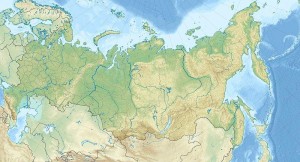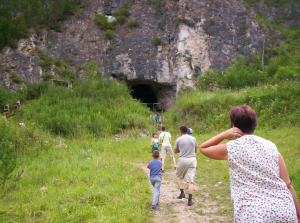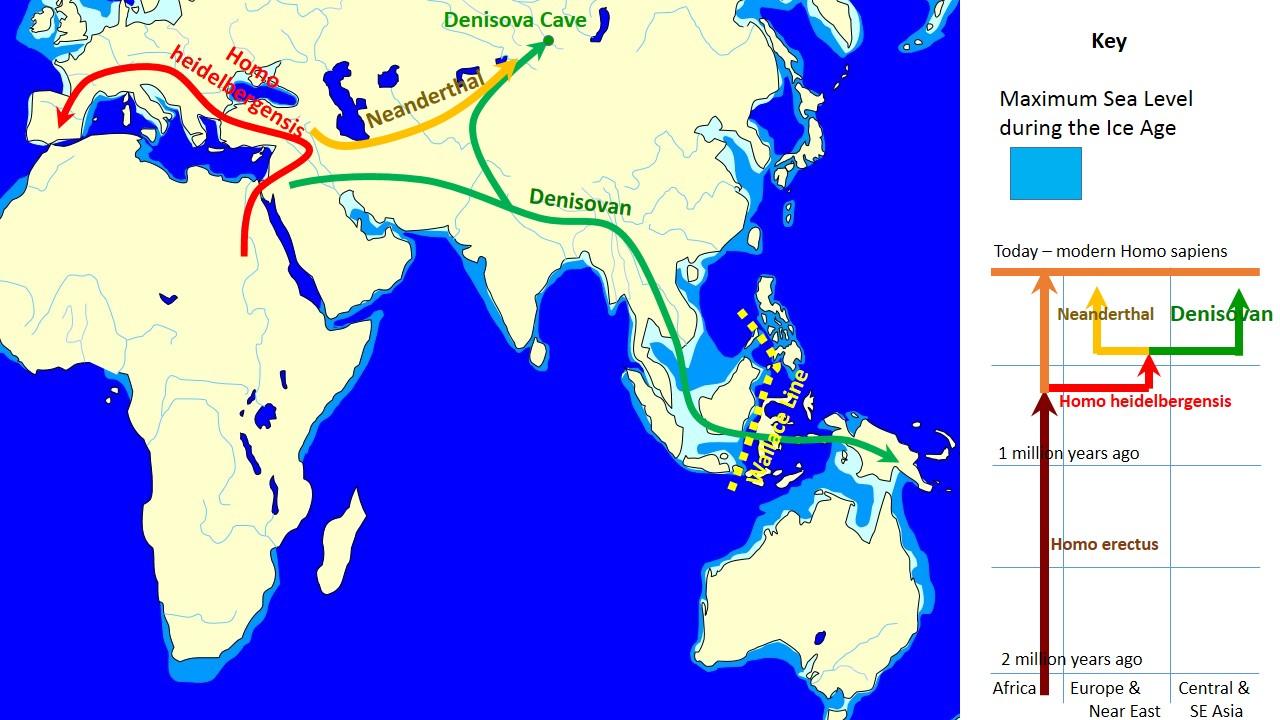34. The Denisovans
THE DENISOVANS
A New Species of Hominin
SITE
Denisova and Okladnikov Caves in the Altai Mountains of Russia
PEOPLE
Michael Shunkov and Anatoly Derevianko

INTRODUCTION
In 2008, Russian scientists Michael Shunkov (paleontologist) and Anatoly Derevianko (archaeologist) discovered a terminal finger phalanx from a young girl, dubbed “X-woman,” in the Denisova Cave in the Altai Mountains of Russia (see Figures 34.1 and 34.2). The Denisovans, as they have come to be called, inhabited the cave by 50 kya.
PHYLOGENY
The phalanx was sequenced by Svante Pääbo’s lab at the Max Planck Institute, where it was determined to be from a new form of extinct hominin. Its ancestor is thought to have split from our own lineage by >800 kya, subsequently splitting into the Denisovan and neandertal lineages ~640 mya (Callaway 2013). The two resulting lineages remained as genomically alike as two geographically distant modern human populations. Pääbo (2014) uses the example of Finns and the San people of South Africa. It is estimated that gene flow from neandertals to Denisovans was fairly low (≥0.5%) and seemingly occurred only locally in the Altai region (Prüfer et al. 2013). What is even more interesting from our perspective is that Denisovans seem to have interbred with the first wave of AMH as they passed through southern Asia after leaving Africa. These humans already carried neandertal genes from having interbred with them. Thus modern human populations that have descended from those early humans (i.e. indigenous Melanesians, Polynesians, Australians, and some Filipinos) carry 4.8% Denisovan genes, along with the mean of 2.5% neandertal genes that all Eurasians possess, meaning that a total of ~7% of their genes are derived from extinct hominins! Genes for dark skin, hair, and eyes were present in the Denisovan genome and are present in modern Melanesians (Marshall 2013). This is fascinating from two perspectives. First, it is interesting that those ancestral characteristics survived in a modern population. Second, we now know something about what the Denisovans likely looked like. Wow!
The Denisovan-like genes that the rest of Eurasians possess may have been inherited from neandertals, due to their close genetic relationship with the Denisovans. It is of great interest that the genetic variability in one of our important immunological systems, the human leucocyte antigen (HLA) system, is probably due to interbreeding with neandertals. Half of the HLA variant genes, termed alleles, seen in Eurasian populations are derived from those two extinct species (Abi-Rached et al. 2011). What is fascinating is that those alleles likely conferred a selective advantage on some of our ancestors, and they thus survived in their descendants. It is likely that neandertals and Denisovans inherited the allele(s) from H. heidelbergensis, lending further support for the latter species having diverged from our lineage prior to the mutation(s) that led to the forms present in the former two species.
Finally, a variant of the EPAS1 gene in Tibetans has also been traced to the Denisovans. The allele is an adaptation to the hypoxic (i.e. low oxygen) conditions of high altitude. The allele affords those individuals with better oxygen metabolism capabilities (Huerta-Sanchez et al. 2014).
Mitochondrial DNA (mtDNA) from a 400 kya femur from the Sima de los Huesos site in Spain has been found to most closely resemble Denisovans (Callaway 2013). The site contains Homo heidelbergensis material, and if the leg bone is from an individual of that species, it will further muddy the phylogenetic waters. However, it must be remembered that mtDNA gives only maternal lineage information, and it is thus possible that the individual was not more closely related to Denisovans but that the mtDNA alleles were conserved in his or her lineage.

DISCOVERY AND GEOGRAPHIC RANGE
In addition to Denisova Cave, Shunkov and Derevianko also found bone fragments in the nearby Okladnikov Cave. They have since recovered two teeth and a toe bone.
The caves were also occupied by neandertals and humans at various times over the millennia. Prior to the discovery of neandertals in the area, it was thought that they ranged no farther east than Uzbekistan. This new discovery extends their geographic range by 2,000 km. The Denisovans also must have had a large geographic range, since they are thought to have bred with AMH as they passed through southern Asia (see Figure 34.3). It is amazing that for over 100 years, the only extinct hominins that we knew of in the northern hemisphere were the erectus-forms and neandertals and now, in just the last couple of years, we have two more, the Denisovans and the Red Deer Cave hominins. (Pääbo 2014, unless otherwise indicated.)

PHYSICAL CHARACTERISTICS
While there is not much to go on, the finger bone was broad and robust relative to modern humans and the molars were large with widely diverging roots, unlike the little or no space between neandertal molar roots. The robusticity of the phalanges suggests that the Denisovans may have been morphologically similar to neandertals (Reich et al. 2010).
ENVIRONMENT AND WAY OF LIFE
The environment of the area must have been at least seasonally cold. Mountains surrounding the area were covered with glacial ice during the Late Pleistocene (Lehmkuhl et al. 2011). However, it is possible that game may have been available year-round in the lower elevations. If large game migrated seasonally, then the hominins would have followed and thus would have only resided in the area when animals were on their northern grazing and birthing grounds.
Since H. heidelbergensis was cognitively and culturally advanced, the Denisovans were descended from them, and Denisovans interbred with neandertals in the Altai region at some point(s) in time, it is likely that they all had similar behavior and culture. While complex tools and an ivory bracelet were found, it is not known whether they are attributable to the Denisovans. They are more likely AMH artifacts, as they are usually only found at AMH sites.

